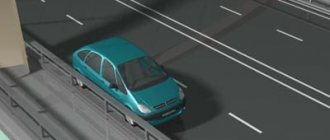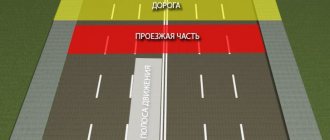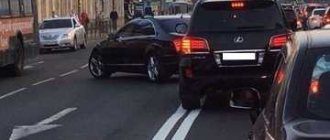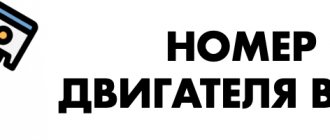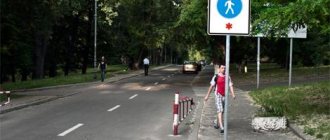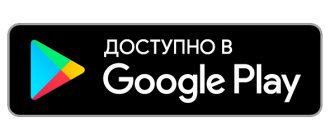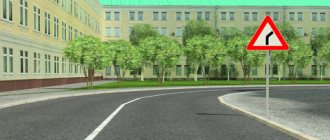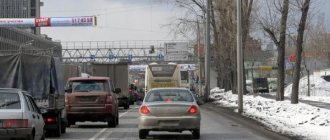When is the fine for driving into the oncoming lane imposed in 2021?
The monetary fine imposed for driving into the oncoming lane in 2021 varies. It depends on many factors. Must correspond to the article for which the protocol is drawn up. We will look in detail in what situations you have to pay for this driver’s misconduct.
Attention! If you have any questions, you can chat for free with a lawyer at the bottom of the screen or call Moscow; Saint Petersburg; Free call for all of Russia.
The amount of fines for driving into the oncoming lane in the wrong place and the specifics of their purpose are prescribed in the Code of Administrative Offences.
Avoiding obstacles
The driver regularly encounters all sorts of obstacles. To continue driving, he is forced to enter the lane in the oncoming direction through a solid line or in a place where overtaking is prohibited. In any case, the rules are broken. But sometimes moving forward in any other way is not possible. For example, when there is a fallen chestnut tree in the middle of the roadway or there is a car that is broken or damaged in an accident.
The consequences of avoiding an obstacle in the oncoming lane in a place prohibited by traffic regulations are described in detail in the third part of Article 12.15. For illegally driving around an obstacle in 2021, the violator behind the wheel will have to pay a fine of 1,000 to 1,500 rubles. But the driver’s license will definitely remain with the driver.
Please note that according to the law it is considered an obstacle (clause 1.2. Traffic regulations of the Russian Federation). It is only a stationary object that does not in any way allow movement to continue. For example, these could be:
- a hole or dip in your lane;
- fencing during road repairs;
- fallen tree, pillar;
- a car with an emergency sign posted behind it;
- anything else that is stationary and prevents a motorist from passing.
The definition of an obstacle does not include a small unevenness, a puddle, potholes, a traffic jam, a bus or trolley bus disembarking passengers. For these situations, a more serious provision of the administrative code applies.
Part four of Article 12.15 of the Code of Administrative Offenses states that in case of driving into the oncoming lane in the absence of a stationary obstacle, the culprit must pay 5,000 rubles. There is also an alternative option. If the court considers the violation of the rules too dangerous, the driver will not be able to return to the wheel. The period for deprivation of a driver's license is from 4 to 6 months.
Overtaking
Traffic jams are a fact that drivers in big cities have to deal with. While everyone is patiently standing in yet another traffic jam, some are trying to get around it. The traffic jam does not fall under the category of obstacles, since it is constantly moving, albeit at a minimum speed.
The driver is strictly prohibited from crossing the solid line. Moreover, overtaking by entering the oncoming lane is strictly prohibited in the following situations:
- on the zebra crossing;
- at controlled intersections, as well as at unregulated intersections, when a motorist is moving along one of the secondary roads;
- in tunnels or on bridges;
- at the railway crossings themselves and a hundred meters before the barrier marking them;
- on risky turns, at the very end of steep and dangerous climbs, under other conditions when visibility is very poor.
The list of situations is given in paragraph 11 of the Russian Federation Traffic Regulations.
When a driver ignores the rules for overtaking by entering the oncoming lane, in 2021 he is required to pay a fine of 5,000 rubles. The judge can also take away your license for 4 to 6 months. Punishments for negligent motorists are prescribed in the fourth part of Article 12.15 of the Code of Administrative Offenses of the Russian Federation.
U-turn
You can understand whether you are a violator during the maneuver of turning your car into the oncoming lane by carefully studying the specific situation. Whether U-turns and left turns are allowed in a certain place on the roadway depends on the road signs and painted markings.
When making a U-turn at an intersection along a trajectory that is too wide, the driver often ends up in the opposite lane. Continuing the started turn, it crosses the double solid line. If this happens perpendicular to the markings, he will be punished under the second part of Article 12.16 of the Code of Administrative Offenses for failure to comply with the markings. In 2021, you will have to pay a fine of 1,000 to 1,500 rubles.
Traffic police officers record a more serious violation when a driver, leaving the intersection of roadways, ends up directly in the oncoming lane. In this case, his actions fall under the fourth part of Article 12.15 and are qualified as driving into the oncoming lane. Punishment is a fine of 5,000 rubles, deprivation of rights for a period of four months to six months, and in case of relapse - for 1 year.
One Way
This violation of traffic rules of the Russian Federation is described in the third part of Article 12.16 of the Code of Administrative Offences.
When a driver drives onto a one-way road in the opposite direction, he is punished with a fine. Its size is 5,000 rubles. In addition, the culprit’s license may be taken away for a period of 4 to six months.
Reverse movement
This method of organizing traffic is common in large populated areas, where traffic jams constantly occur due to the huge number of cars and public transport.
Movement along a single lane can be carried out in opposite directions. Everything depends on time. When driving in reverse, drive strictly according to the traffic light signal. For example, in the mornings, more exit lanes are left from residential neighborhoods, when everyone goes to work. When residents return home in the evenings, more lanes appear at the entrance. This method allows you to effectively solve the problem of congestion and traffic jams.
For a driver who drives into a reversible lane under a prohibiting traffic light, which at a certain moment is intended for oncoming traffic, the inspector will issue a fine of 5,000 rubles or deprive him of his license for six months (Article 12.15 Part 4 of the Code of Administrative Offenses). If the driver manages to prove that in a previous case he committed a violation by driving around a certain obstacle, the fine will be from 1,000 to 1,500 rubles (Article 12.15. Part 3 of the Administrative Code).
Oncoming traffic lane
Before considering cases of driving into oncoming traffic, it is necessary to define driving into the oncoming lane. This issue is regulated by the Traffic Rules, approved by Decree of the Government of the Russian Federation of October 23, 1993 N 1090 “On Traffic Rules”. Clause 1.2 of the Rules is devoted to defining the meaning of terms and concepts that appear in the text and must be understood unambiguously by everyone in order to prevent deviations from their original meaning. This paragraph states that a traffic lane is any of the longitudinal stripes of the roadway, marked or not marked with markings and having a width sufficient for the movement of cars in one row.
The Rules do not contain an unambiguous answer to the question of what is considered driving into the oncoming lane, but this is not difficult to establish from the general meaning of the Rules. We have found out what a “traffic lane” is, now from a linguistic point of view it is not difficult to establish that the oncoming traffic lane is a lane along which traffic is carried out “toward”. Also, clause 1.4 of the Rules can be involved in resolving this issue, which states that traffic in the Russian Federation is carried out on the right side.
Summarize. The law does not contain an official definition of what is considered driving into oncoming traffic, but it does contain definition criteria. Based on them, we can formulate a definition: oncoming traffic lane - a traffic lane, with or without markings, located to the left of all lanes in the same direction, movement along which is carried out in the direction opposite to the direction of movement of the driver.
Important!
Please note that from the definition of a traffic lane, it follows that the absence of markings does not make the roadway one-lane . Some unscrupulous drivers think that if there are no markings, you can drive on such a road as you please. In practice, it turns out that driving into oncoming traffic will be considered to have occurred, even if the road is not visually divided into lanes. In the everyday lexicon you can often find the phrase “cross a continuous line” in the sense of entering the lane of oncoming traffic, but if you look into it, it turns out that this is not always the same thing.
The Rules state that in the absence of markings, the driver must determine the lanes independently. Two factors must be taken into account: the width of the road and the overall dimensions of the car. How many cars can fit on the road at the same time, there are so many lanes on it. The only strict rule in this matter is the evenness of the number of stripes . This means that if the width of the roadway simultaneously accommodates 3 cars, then there will be only two lanes; if there are 5 cars, then 4. In the absence of markings, it is assumed that each of the directions of traffic, opposite to each other, should have an equal number of lanes with the other direction for movement.
Traffic rules establish that the side of oncoming traffic in the absence of markings will be half the width of the road, located on the left side.
Analyzing these provisions, we understand that the side of the oncoming movement is established not only on formal grounds, but also on the basis of substantive criteria. This means that we will consider the oncoming lane to be that part of the road where traffic is moving towards us.
What is the fine for driving into the oncoming lane?
| Type of violation | Article and the relevant part of the Code of Administrative Offenses | Amount of fine | Is a discount possible? |
| Let | Art. 12.15 p.3 | 1,000 – 1,500 rubles | Yes |
| Overtaking | Art. 12.15 p.4 | 5,000 rubles or deprivation of rights (4 - 6 months) | Yes |
| U-turn | Art. 12.16 p.2 | 1,000 – 1,500 rubles | Yes |
| Entering a one-way lane | Art. 12.16 p.3 | 5,000 rubles or deprivation of rights (4 - 6 months) | Yes |
| Entering a lane with reverse traffic | Art. 12.12 p.1 | 1,000 rubles | Yes |
| The appearance of cars on tram tracks | Art. 12.15 p.3 | 5,000 rubles or deprivation of rights (4 - 6 months) | Yes |
Deprivation for driving into oncoming traffic
Article 12.15.4 lists the situations in which a driver can be disqualified for driving into the oncoming lane in 2021. It happens:
- When a motorist appears on a one-way road facing traffic or on oncoming tram rails (from four to six months). If this moment is caught on video cameras, a fine of 5,000 rubles will be issued.
- Repeated violation of the clause specified in the previous paragraph will result in deprivation of rights for one year (12.15.5).
- 5,000 rubles or deprivation of rights (4 - 6 months) is applicable when crossing a single or double solid line. This happens when overtaking, turning or during a U-turn when you cannot fit into a broken line.
- You cannot drive into the oncoming lane on a road with 4 or more lanes. Turns and U-turns are allowed only in specially designated areas.
- If the road is three-lane (the middle lane is used for traffic in both directions), the motorist will remain without a license for appearing in the leftmost lane, as well as when overtaking in the situations listed in the same paragraph of this article.
In all these cases, imprisonment for a period of four to six months.
The traffic police officer, having drawn up a protocol, transfers the case to the court. He has no right to confiscate his driver's license. The judge can make the corresponding decision as an additional or primary punishment. The case is reviewed within 20 days after the incident.
If the court decides not in favor of the motorist, the license must be handed over to the traffic police within 3 days.
Other situations
The driver has the right to drive in oncoming traffic if there is a vehicle in his lane with emergency lights. In accordance with the traffic rules, such an obstacle can only be driven around on the right side along the side of the road. However, if it does not meet the required parameters, for example, it is small or there is a high curb, then you can drive around on the right, crossing the solid line.
When a driver turns through a solid lane and does not reach the intermittent markings, he is subject to a fine of up to several thousand. Or you are leaving the yard, and there is a solid line in front of you when turning left. Such an offense will result in penalties, but rights will be retained.
As in the previous situation, if a person leaves a lane, turns left, or is cut off by another car, as a result of which he crosses a solid lane and enters oncoming traffic, then the offense will result in a fine. Deprivation of rights for such actions on the road is not provided.
Punishment for driving into the oncoming tram lane
The legality of a motorist being on tram rails is determined by which direction they lead. If in the same direction, then inspectors even have a number of situations when they strongly recommend using the tracks.
It is allowed to turn left or make a U-turn from tram tracks. It is imperative that two conditions be met. Such maneuvers should not contradict markings and signs. It is unacceptable to interfere with the tram itself.
Cars are not allowed to appear on oncoming tram rails. For violation, a fine of 5,000 rubles is paid. You can be left without a license for six months (Part 4 12.15 of the Administrative Code).
Which tram tracks can you travel on without fear?
So, is to cross the lane where trams go ? Don't be discouraged - sometimes it's possible. And here are the cases:
- on passing rails;
- if the tram rails are on the left;
- the tram track lies at the same level as the roadway.
Driving straight along passing tram tracks not at an intersection is only possible if there is no longer a single free lane left on the road. Traffic rules allow movement on tram rails also when turning left and making a U-turn.
When can you drive into oncoming traffic in 2021?
We list the traffic situations when driving into the oncoming lane is possible:
- avoiding an accident, pothole, or other obstacle when driving in your lane becomes impossible;
- on a narrow road, provided that overtaking a slow-moving vehicle is not prohibited;
- overtaking on a section of the highway where a solid line turns into a broken line;
- on 3-lane roads, when the middle lane is intended for traffic in opposite directions (it is allowed to appear on it for overtaking, making a left turn, making a U-turn);
- an attempt to avoid a collision or any other potential accident (these actions fall under Article 2.7 of the Administrative Code).
In the last example, the driver will not be punished, but the traffic police inspector is obliged to issue him a verbal warning.
Cases when driving into oncoming traffic is permitted
Punishment for driving into the oncoming lane is not always qualified under the above articles. Making a maneuver to bypass an object that interferes with traffic threatens the driver with a fine for driving into the oncoming lane in the amount of 1,000 to 1,500 rubles and is qualified as “a U-turn or a turn on the road in violation of the requirements of signs and markings” under paragraph 2 of Article 12.16 of the Administrative Code.
There are a number of situations in which driving into the oncoming lane under traffic rules does not entail punishment:
- on a narrow road with markings and signs that do not prevent you from entering the oncoming lane for the purpose of overtaking;
- avoiding an accident, a dip in the road or other obstacles in the oncoming lane when it is impossible to avoid in your own lane;
- turning on a road marked with three lanes in the absence of prohibitory signs;
- overtaking at the point where the broken line transitions to a solid line;
- entering the lane of oncoming traffic for the driver in order to avoid an accident (the traffic police officer issues a verbal warning).
Procedure for imposing a fine
If the rules are broken, you will have to answer in one of two cases. The act could have been caught on camera. After some time, you will receive a request by mail to pay a fine for driving into the oncoming lane. If you are planning to protest what happened, you should go to court or the traffic police. You have 10 days to appeal the fine. The countdown begins from the day a copy of the resolution is received (Article 30.3 of the Administrative Code).
The second situation is when the car is stopped by an inspector who was directly present when the offense was committed.
It is worth noting that in 2021, the inspector must have good reasons to stop the vehicle (clause 84 of the Administrative Regulations for Enforcement of the Ministry of Internal Affairs). These include:
- traffic violation;
- the emergence of information about the probable involvement of the person in the car in the crime;
- availability of information that the car is wanted;
- the need to conduct a survey about the accident;
- restriction or prohibition of movement;
- involving a motorist or his car in providing urgent assistance;
- inspection of the vehicle and documents (permitted only at a checkpoint or a stationary post).
The police officer must introduce himself fully. Immediately note why the car was stopped (clause 1 of part 4 of article 5 of the law “On the Police”). The driver is allowed not to leave the vehicle. Paragraph 93 of the Traffic Police Administrative Regulations states that the inspector only offers to leave the vehicle. Typically this is required in the following cases:
- cargo inspection;
- troubleshooting technical problems;
- suspicions that the driver is drunk or under the influence of drugs.
The driver himself decides to obey or not.
Next, a protocol is drawn up. This is an official document drawn up in case of an administrative offense. It is filled out by the inspector on site. It describes in detail the administrative offense committed - driving into the oncoming lane. If the offense was minor, the inspector immediately makes a decision on the case. You can agree with the fine or appeal it. According to Article 1.5 of the Code of Administrative Offenses, a citizen cannot be found guilty until it is proven.
A protocol is drawn up immediately after the alleged culprit has been allowed to enter the oncoming lane. This is stated in Article 28.5 of the Administrative Code.
If additional facts related to the incident need to be clarified, the time limit for drawing up the protocol increases to 2 days. A so-called administrative investigation may also be required. In this case, the deadlines are set separately.
There are several points that are important to reflect in the protocol. This includes the following information:
- actions of the traffic police inspector and other officials;
- the condition of the road and its quality, marking features, as well as the presence of lighting on the section where a possible violation of the rules occurred;
- features of the intersection, important details: priority signs when moving, whether the traffic light was working, etc.;
- other significant details.
The names and contact details of witnesses and victims, if any, are recorded in the protocol. Everyone, including the culprit, is required to provide an explanation. The article of the Code of Administrative Offenses that was violated when driving into the oncoming lane must be indicated. The situation that led to the incident is described in detail.
To prevent the inspector from entering false information into the protocol, a Z sign should be placed in the empty fields of the form.
Evidence of the driver entering the oncoming lane can be video recordings of the incident, photographs, or a diagram of the violation.
The inspector only presents evidence to impose a fine on the alleged violator. He is not obliged to explain or comment on them (Article 25 of the Administrative Code).
What should a driver do if a fine is issued for driving into the oncoming lane?
If a motorist is suspected of committing an offense and is given a fine for driving into the oncoming lane, you should know how to assert your rights. It is necessary to study the protocol drawn up, especially how the police officer described the traffic situation.
If the driver does not agree with the fine imposed for driving into the oncoming lane, he must write about this in detail. After all, the court will rely on the protocol when making a decision.
Next, record on video the road conditions and surrounding circumstances. For example, the presence of obstacles, the condition of the road. These facts can serve as evidence of correctness and serve as a basis for a reduced sentence.
After receiving a copy of the compiled document, you have 10 days to appeal it (Part 1 of Article 30.3 of the Administrative Code). If this was not possible for valid reasons, a petition should be filed to restore the period for appeal. Please note that only objective reasons should interfere.
Is there a discount on the fine?
Since the beginning of 2021, the State Traffic Safety Inspectorate has introduced an innovation that should facilitate the timely payment of fines by violators. In 2021, you can pay a fine for driving into the oncoming lane with a 50% discount. 20 days are allotted for this after the relevant decision is issued.
It is worth noting that the discount does not apply to all types of traffic violations. In particular, you cannot count on concessions in the following situations:
- systematic violations (for example, repeatedly driving into the oncoming lane);
- the driver being under the influence of drugs or alcohol;
- Causing minor or moderate injuries to victims of road accidents.
In other cases, you can take advantage of the discount.
Appeal
You must file a complaint with the agency that issued the fine. It is considered within a maximum of 10 working days (Article 30.5 of the Administrative Code).
A fine drawn up and assigned by the State Traffic Inspectorate can be challenged in several ways:
- online – write a complaint on the traffic police website;
- in person (contact the department of the State Traffic Inspectorate that issued the decision);
- send your appeal by mail.
You also have the right to go to court at the location of the traffic police department or the driver’s place of residence.
By the way, if a fine for driving into oncoming traffic was paid, and then a decision was made about illegality and cancellation, you can get the money back. To do this, you need to submit an application, attaching a package of documents:
- copy of passport;
- bank account details;
- documents confirming the payment;
- decision to cancel the fine (instead of the original, it can be a copy).
Applications to appeal a fine for driving into the oncoming lane can be found here.
How to avoid a fine for driving into the oncoming lane in 2021?
If a violation has occurred, you must do everything possible to avoid a fine or minimize the punishment. In 2021, it is recommended to follow the following algorithm:
- Make sure that all facts are reflected in the protocol. If the inspector missed something, it is necessary to note the disagreement, and then describe in detail all the important circumstances of driving into the oncoming lane.
- It is important to reflect in the protocol itself or the included notes how events unfolded. It is necessary to describe the degree of illumination and time of day, clarify the presence of traffic signs and the state of markings. Note how well the markings and signs were visible.
- The protocol indicates the contacts of all witnesses, including passengers of the car.
- You need to try to get as much evidence as possible. Photographs and a detailed diagram of what happened with relevant measurements will help. It would be good if there were witnesses. Photos must be local.
To minimize the punishment for driving into oncoming traffic, you can ask to consider mitigating circumstances. According to Article 4.2 of the Administrative Code, these include repentance, admission of guilt, absence of previous offenses, a state of passion, even poor health or pregnancy.
Consequences of ignoring traffic rules
The punishment for violating the rules will depend on the severity of the offense committed.
Movement in the same direction
Firstly, the car drove onto tram tracks intended for movement in the same direction. But the driver ignored the presence of continuous markings or a prohibitory sign. A rather mild punishment will follow - a fine of 500 rubles. They will be punished for ignoring signs and markings.
Secondly, the driver, while making a maneuver, recklessly interfered with the tram. Although he went in the permissible direction. Fine - 500 rubles.
Driving in the opposite direction
- The driver drove around an obstacle (for example, a broken tram or the scene of an accident) and drove into the oncoming lane of the tram. Fine - from 1 thousand rubles. up to 1.5 thousand rubles.
It needs to be taken into account. Neither a traffic jam nor a traffic jam is considered an insurmountable obstacle.
- If the exit is made onto tram tracks in the opposite direction, then they will be punished in the same way as if the transport was moving in the “oncoming lane”, which is separated by a solid line from the passing lane. They are punished in different ways:
- If a traffic inspector records a violation, the driver will pay 5 thousand rubles. fine;
- if the violation was recorded by a camera (automatically), then the driver faces only a fine, without opening an administrative case.
- You can also be punished for using tram tracks to make a U-turn. Then the “oncoming traffic” should be crossed extremely carefully. It is recommended to drive through the area with rails at a strictly right angle. If the driver decides to cut a corner, moving along oncoming roads, the traffic inspector will regard such a maneuver as blatant driving in the oncoming lane. In fact, an innocent driver will be justifiably deprived of his license.

